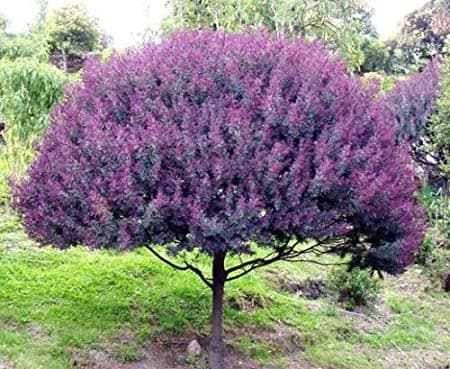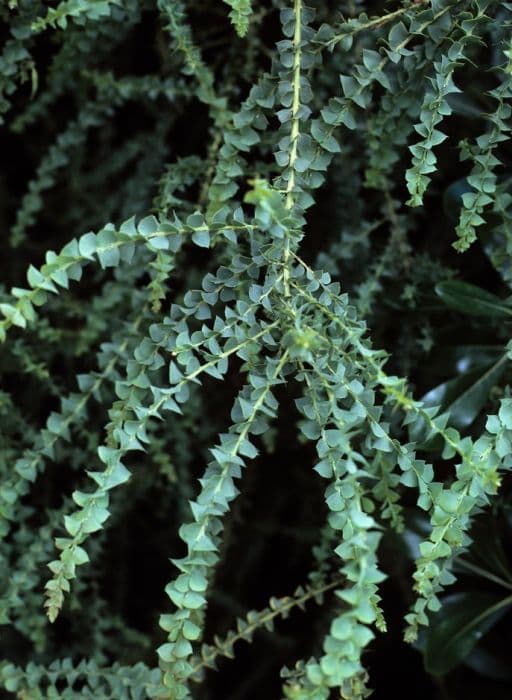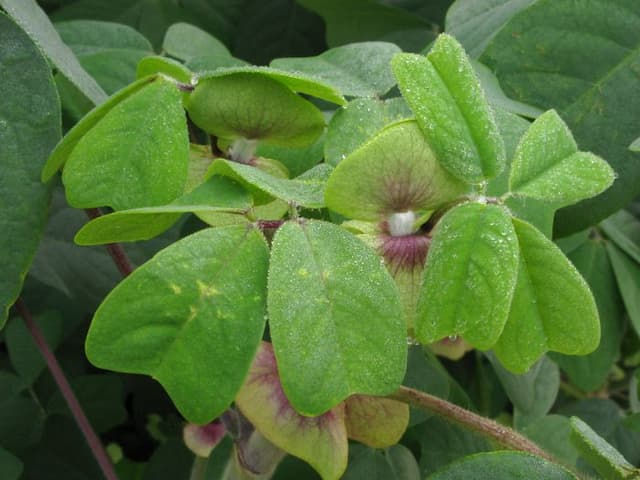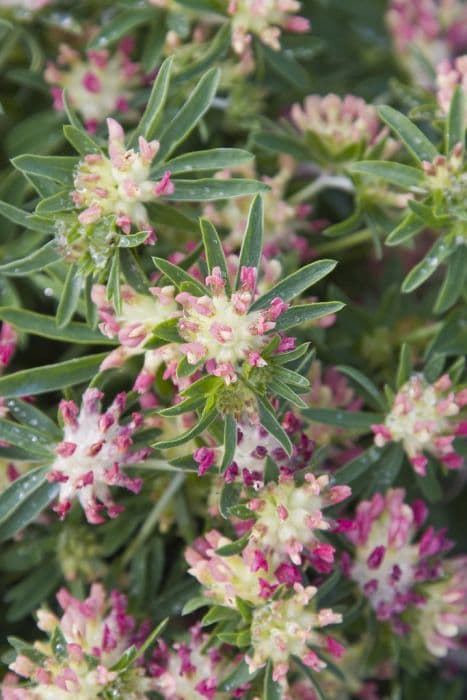Sweet pea Lathyrus odoratus 'Heathcliff'

ABOUT
Lathyrus odoratus 'Heathcliff', commonly known as sweet pea 'Heathcliff', is a delightfully fragrant flowering plant. It has an old-fashioned charm with bold, yet delicately formed flowers. The blooms of 'Heathcliff' possess a rich hue, often described as deep violet or blue-purple, which can be a draw for garden enthusiasts looking for intense color. Each blossom has a standard petal at the top, with wing petals on the sides that may be slightly paler, providing a lovely contrast. The petals have a silky texture and are intricately veined, which adds depth and complexity to their appearance. Sweet pea 'Heathcliff' bears its flowers in clusters, creating a lavish display of color that can enliven any garden space. The plant's foliage is made up of pinnate leaves, which are bright green and comprised of multiple leaflets. Thin, tendril-like growths emerge from the leaf axils, enabling the plant to climb and hold onto supports, giving it a vining habit. The sweet pea 'Heathcliff' is famous not only for its visual appeal but also for its delightful scent. The fragrance can be described as sweet and heady, with a strong aromatic presence that makes it a favorite among scented garden blooms. Overall, 'Heathcliff' is celebrated for its graceful appearance and its ability to infuse the air with its enchanting perfume.
About this plant
 Names
NamesSynonyms
Sweet Pea, Heathcliff Sweet Pea.
Common names
Lathyrus odoratus.
 Toxicity
ToxicityTo humans
Sweet pea, the common name for Lathyrus odoratus 'Heathcliff', is mildly toxic to humans if ingested. The seeds and seed pods are the most toxic parts of the plant. Ingesting the seeds can lead to symptoms such as nausea, vomiting, abdominal pain, and convulsions in severe cases. Repeated consumption may result in a condition called lathyrism, which may cause muscle weakness and paralysis, particularly in the legs, due to the neurotoxin ODAP (beta-N-oxalyl-L-alpha,beta-diaminopropionic acid) present in the seeds.
To pets
Sweet pea, the common name for Lathyrus odoratus 'Heathcliff', poses a toxicity risk to pets if they consume the plant, particularly the seeds and seed pods. Symptoms of poisoning in pets can include lethargy, pacing, head pressing, tremors, seizures, and difficulty breathing. Continuous or large ingestion can lead to more serious neurological issues, such as lathyrism which affects the nervous system, potentially causing paralysis, especially in hind limbs. It's important to prevent pets from having access to sweet peas to avoid any toxic effects.
 Characteristics
CharacteristicsLife cycle
Annuals
Foliage type
Deciduous
Color of leaves
Green
Flower color
Varies
Height
6 feet (1.8 meters)
Spread
1 foot (0.3 meters)
Plant type
Climber
Hardiness zones
2-11
Native area
Mediterranean
Benefits
 General Benefits
General Benefits- Aesthetic Appeal: Lathyrus odoratus 'Heathcliff', commonly known as sweet pea, produces beautiful, colorful blooms that enhance the visual appeal of gardens and landscapes.
- Fragrance: Known for its delightful fragrance, sweet pea can bring a pleasant scent to outdoor spaces and cut flower arrangements.
- Pollinator Attraction: The flowers attract beneficial pollinators such as bees and butterflies, promoting biodiversity and healthy gardens.
- Vertical Growth: As a climbing plant, sweet pea can be used to cover trellises, fences, and other vertical structures, adding dimension and interest to garden designs.
- Ease of Growth: Sweet peas are relatively easy to grow and maintain, making them suitable for gardeners of all skill levels.
- Seasonal Interest: With a blooming season typically in the spring and early summer, sweet pea provides seasonal color when many other plants have not yet peaked.
- Variety of Uses: Ideal for cut flowers, borders, and container gardening, sweet pea offers versatility in its uses for gardeners and floral enthusiasts.
- Decorative Seed Pods: After blooming, sweet pea produces ornamental seed pods that can add interest in the garden and can be used in dried floral arrangements.
- Edible Peas: While the flowers and seeds of certain Lathyrus odoratus varieties are not edible and can be toxic if ingested, some other species in the Lathyrus genus do produce edible peas.
 Medical Properties
Medical PropertiesThis plant is not used for medical purposes.
 Air-purifying Qualities
Air-purifying QualitiesThis plant is not specifically known for air purifying qualities.
 Other Uses
Other Uses- The sweet pea can be used in potpourri to lend its fragrant aroma to a mixture of dried flowers and spices, creating a natural air freshener for rooms.
- Dried sweet pea flowers can be incorporated into handmade paper, providing a decorative touch and subtle fragrance to the final product.
- Sweet pea vines can be used in floral art, providing a natural framework or support for more elaborate designs due to their climbing nature.
- The flowers can be used as a natural dye for fabrics, offering hues of blues and purples depending on the mordant used.
- As an educational tool, sweet peas can be used to demonstrate principles of plant biology and genetics, as they were key in Gregor Mendel's early genetic studies.
- In a sensory garden, sweet peas provide a multisensory experience with their vibrant colors and sweet fragrance, which can be therapeutic for visitors.
- When planted as cover crops, sweet pea vines can improve soil health by fixing nitrogen and adding organic matter when tilled back into the soil.
- As a companion plant in vegetable gardens, sweet peas can help attract beneficial insects that prey upon common garden pests.
- The vines and flowers can be used in crafting, such as making floral crowns or natural jewelry.
- Children's gardens can utilize sweet peas for engaging activities such as "grow-a-maze" where the vines form live green walls in a maze pattern.
Interesting Facts
 Feng Shui
Feng ShuiThe Sweet Pea is not used in Feng Shui practice.
 Zodiac Sign Compitability
Zodiac Sign CompitabilityThe Sweet Pea is not used in astrology practice.
 Plant Symbolism
Plant Symbolism- Pleasure: Sweet peas, including the 'Heathcliff' variety, have been associated with pleasure due to their delightful fragrance and bright, attractive blooms.
- Goodbye: In the language of flowers, sweet peas can signify a farewell or departure, perhaps because they can be given when someone leaves as a way to convey best wishes for a pleasant journey.
- Blissful pleasure: With their captivating scent and delicate appearance, sweet peas are often related to the experience of pure, blissful pleasure.
- Thank you for a lovely time: Sweet peas are sometimes given as a token of gratitude to thank someone for a wonderful experience or enjoyable company.
- Delicate pleasure: The sweet pea represents delicate pleasures, symbolizing the enjoyment of the finer, softer moments in life.
 Water
WaterSweet peas, including the Lathyrus odoratus 'Heathcliff', prefer consistent moisture and should be watered once a week, applying about 1 gallon of water per square yard of soil. During particularly dry or hot periods, they may require additional water, possibly twice a week, to keep the soil evenly moist but not waterlogged. It's important to water deeply and directly at the base of the plants to encourage deep root growth and avoid wetting the foliage, which can lead to fungal diseases. Reducing watering as the flowers start to decline can help signal the plant to produce more seed pods.
 Light
LightSweet peas thrive in full sunlight, and Lathyrus odoratus 'Heathcliff' is no exception. For optimal growth and flowering, plant them in a spot where they can receive at least 6 to 8 hours of direct sunlight each day. They can tolerate partial shade, especially in hotter climates, but too much shade can lead to fewer blooms and leggy plants.
 Temperature
TemperatureSweet peas like Lathyrus odoratus 'Heathcliff' prefer cooler climates and flourish in temperatures ranging between 55°F and 65°F. They can withstand minimum temperatures down to 25°F for short periods but typically do not do well in high heat, with maximum temperatures ideally not exceeding 75°F. Sustained temperatures above this range can cause the plant to stop blooming and potentially wither.
 Pruning
PruningPruning sweet peas like Lathyrus odoratus 'Heathcliff' encourages bushier growth and more blooms. Pinch out the growing tip after the plant has developed several sets of leaves to encourage lateral growth. Deadheading, or removing spent flowers, will promote continuous blooming throughout the season. Pruning is best done regularly, as often as you notice dead or faded flowers and overgrown stems.
 Cleaning
CleaningAs needed
 Soil
SoilFor Sweet Pea 'Heathcliff', a rich, well-draining soil mix is ideal, with a pH between 6.5 and 7.5. Adding aged compost or well-rotted manure enhances soil fertility, promoting lush growth and abundant flowering.
 Repotting
RepottingSweet Peas generally do not require frequent repotting as they are annuals. Plant Sweet Pea 'Heathcliff' seeds or seedlings annually in fresh soil to ensure optimal growth.
 Humidity & Misting
Humidity & MistingSweet Peas like 'Heathcliff' prefer moderate humidity levels but are adaptable and can thrive in average garden conditions without the need for specific humidity control.
 Suitable locations
Suitable locationsIndoor
Ensure bright light, cool temps, and well-draining soil.
Outdoor
Full sun, moist soil, and provide a trellis for support.
Hardiness zone
2-11 USDA
 Life cycle
Life cycleLathyrus odoratus 'Heathcliff', commonly known as the sweet pea 'Heathcliff', begins its life cycle as a seed, which with adequate soil conditions, moisture, and temperatures, will germinate and sprout. Following germination, the seedling emerges and develops its first true leaves, along with a climbing or trailing vine, given its vining nature. During the vegetative stage, the plant focuses on growing foliage and strengthening its stem to support blooms; it requires staking or support for its tendrils to climb. As it matures, Lathyrus odoratus 'Heathcliff' enters the flowering stage, producing fragrant, showy flowers that can be a range of colors, depending on the cultivar. Following pollination, whether by insects or human aid, the plant develops seed pods which mature, dry out, and eventually release seeds, thus completing its reproductive cycle. Under appropriate seasonal conditions, the plant will go dormant, die back in the case of annual varieties, or it will overwinter if grown as a perennial in suitable climates, before beginning the cycle anew.
 Propogation
PropogationPropogation time
Spring
The Lathyrus odoratus 'Heathcliff', commonly known as 'Sweet Pea Heathcliff', is primarily propagated through seeds. The ideal time to sow Sweet Pea seeds is in late winter to early spring, allowing for a period of cold stratification which can improve germination. To propagate Sweet Pea Heathcliff, begin with fresh seeds and plant them about 1 inch deep in well-draining soil, spacing them about 2 to 3 inches apart. It's recommended to soak the seeds in water for 24 hours before planting to soften the seed coat. Once sown, the seeds will typically germinate in 10 to 21 days, depending on the temperature. Ensure that the area is protected from the last expected frosts. As they grow, provide support for the climbing vines and plenty of sunlight for the best flowering results.









